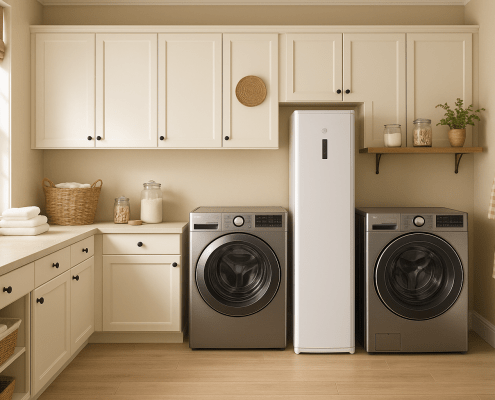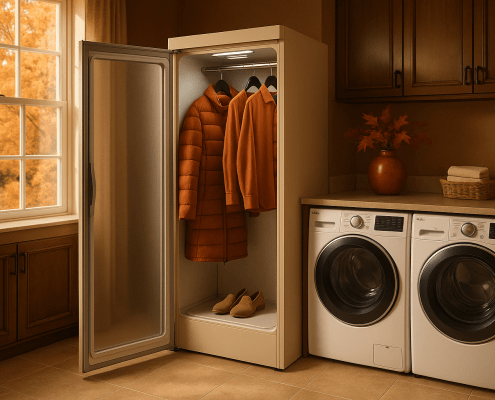Laundry Steam Closet Making Noise? How to Fix the Motor or Fan
Steven E / Tuesday July 8, 2025
Laundry steam closets are supposed to keep your clothes fresh, not drown you out with annoying grinding, buzzing, or rattling sounds. If your steam closet motor or fan has gotten loud lately, it’s usually a sign of something simple. Here’s how to figure out what’s causing the noise and fix it so your steam closet stays quiet and efficient.
The information in this article may not apply to your specific appliance model. We recommend consulting your manufacturer’s documentation or contact us with any questions.
Why Is Your Steam Closet Making Noise?
When everything is working properly, your laundry steam closet should run with just a gentle hum. If you’re hearing anything else, it’s worth investigating.
Common noises and what they mean:
- Rattling or vibrating: Something may be loose or misaligned.
- Squealing or screeching: Usually caused by a dry, worn-out motor bearing or fan bushing.
- Grinding: Could mean debris is caught in the fan blades or the motor shaft is damaged.
- Buzzing or humming loudly: Might indicate the motor is struggling to start or under strain.
These noises can come from the motor itself, the fan blades, or even the mounts that hold them in place.
Tools You’ll Need
Before you get started, gather these supplies:
- Screwdrivers (Phillips and flathead)
- Vacuum or canned air
- Microfiber cloth
- Mild soap and water
- Lubricating oil (for electric motor bearings, if applicable)
- Multimeter (to test the motor)
- Replacement fan or motor, if needed
- Flashlight
Step 1: Power Down the Unit
Safety first, unplug your steam closet from the wall before doing anything else. You’ll be removing panels and working near moving parts, so you don’t want any surprises.
Step 2: Locate the Fan and Motor
On most steam closets, the motor and fan are located in the lower section or the rear of the unit. Remove the access panel to expose the components. You’ll likely see:
- The motor is usually about the size of a soda can, with wiring attached.
- The fan assembly is connected to the motor shaft and enclosed in a small housing.
- Mounting brackets or screws holding everything in place.
Step 3: Inspect for Loose Components
Noise often comes from something simple, a loose screw, bracket, or panel can cause rattling or vibration. Check:
- All mounting screws and brackets. Tighten if loose.
- The fan blades should be firmly attached to the motor shaft with no wobble.
- Any rubber vibration dampeners, if cracked or missing, may need replacing.
- Run your fingers around the edges of the fan blades to make sure nothing’s hitting or rubbing.
Step 4: Clean the Fan Blades and Housing
Dust and lint can build up over time, throwing the fan off balance or clogging up the motor.
- Wipe down the blades with a damp microfiber cloth.
- Vacuum the housing and the surrounding area.
- Use canned air to blow dust out of hard-to-reach areas.
Even a small amount of lint can make the fan noisy and less efficient, so clean it thoroughly.
Step 5: Check for Debris or Obstructions
Look inside the fan housing and motor area for anything that doesn’t belong. Stray lint, small pieces of fabric, or even an errant screw can cause grinding or buzzing sounds. Remove any debris you find.
Step 6: Test the Motor Bearings
A dry or worn-out bearing is one of the most common causes of squealing or screeching. To test:
- Spin the fan blades gently by hand.
- They should turn freely and quietly, with no resistance or noise.
- If they feel stiff, gritty, or make a high-pitched squeal, the bearings likely need attention.
If your motor has oil ports, apply a few drops of light machine oil to the bearings and spin the shaft to work the oil in. If lubrication doesn’t help, the motor may need replacing.
Step 7: Test the Motor Electrically
If cleaning and tightening haven’t solved the problem, you’ll want to check if the motor itself is functioning properly.
Use a multimeter to test for continuity:
- Set the meter to the ohms setting.
- Disconnect the motor wires from the control board.
- Place the meter probes on the motor terminals.
- You should get a steady reading; if it shows open (infinite resistance), the motor coil is likely burned out.
If the motor fails this test or continues making excessive noise despite lubrication, it’s time to replace it.
Step 8: Replace the Motor or Fan
If you’ve determined that the motor or fan is faulty, replacing it is straightforward:
- Disconnect the wiring harness.
- Remove the mounting screws or bolts holding the motor in place.
- Slide out the motor and fan assembly.
- Position the replacement motor and fan in the same orientation.
- Secure it with screws or bolts.
- Reconnect the wiring harness.
- Make sure the fan blades spin freely and don’t touch the housing.
Close up the access panel once everything is secure.
Step 9: Run a Test Cycle
Plug your steam closet back in and run a short cycle to test your repair. If all sounds normal, congratulations, you’ve successfully repaired your noisy steam closet!
Where To Find Us
If you need any replacement parts for your appliances, you can enter your model number at AppliancePartsPros.com to locate and order them quickly. Most orders arrive in just two business days, and we have tons of great information in our repair help section and YouTube videos to help you troubleshoot.
Stay connected with the latest DIY tips, tutorial videos, and repair guides by following us on Facebook, Instagram, and Twitter. We love hearing about your repair stories and successes. If you need more help or want personalized guidance, feel free to reach out. We’re ready to help you take on your next project with confidence!
With nearly a decade of experience in providing top-notch customer service regarding appliance parts and repair, Steven enjoys sharing practical advice, troubleshooting tips, and interesting information to help readers stay informed.





